Beetham, Isabella, Mrs (McKechnie Section 2)
See Section Three for main entry
Some of the profiles painted on paper in the mid-1780s at Mrs Beetham's studio at 27 Fleet Street, London, appear to have been painted much in the style of work which has been attributed to Mrs Bull (q.v.), who probably assisted Mrs Beetham when the latter was at her busiest (c. 1785) and may have painted these profiles herself. Such examples are illustrated under Mrs Beetham's name, but the likely attribution to Mrs Bull is mentioned in the captions. For a discussion of Mrs Bull's style, both in the work which emanated from Mrs Beetham's studio (but which I attribute to Mrs Bull) and in her undoubtedly independent work, see the entry on her.
All work on paper by Mrs Beetham which is indisputably identifiable from a trade label, is painted on rather thick paper, similar to modern cartridge paper, as is Mrs Bull's work.
There seems to be no evidence that Mrs Beetham's daughter, Jane Read, painted any of the profiles on paper at the time when she was assisting her mother during the 1790s. In any case, fewer profiles were executed on paper during that decade than in the 1780s, and artists were producing much more work on glass.
Mrs Beetham's work was executed either in bust-or three-quarter-length; the bust-line termination almost always shows a double-loop concavity, which varies, within limits, as it does on Mrs Beetham's profiles on glass.
The 1780s were notable not only for the popularity of paper profiles, but also for the attractiveness of the costume which could be rendered on them, and which Mrs Beetham painted with great skill. She painted hair in long, sweeping lines, hairs outside the main image often being shown singly, as if painted with a quill or a single-hair brush. Mrs Beetham sometimes used as many as twenty-four different strokes to show only one of the curls on the à la conseilleur and 'three ringlets' hair-styles which were coming into fashion for women by 1786. She painted the long tresses at the back with similar skill against a wash background, also used for curls near the face to give depth to the portrait. On profiles of men also, she painted hair in sweeping lines, and many examples show little strokes at the back of the head, outside the main image, which give a 'brushed-back' effect. Ribbons on her profiles of men are most easily recognizable from the slight variations in shape shown on the illustrated examples.
Mrs Beetham renders clothing with consummate skill, and in full detail, including the fashionable striped waistcoats worn by men at the time. She painted men's shirt-frills in a variety of techniques: cross-hatching is in evidence on some examples; for others she adopted a style similar to that of Mrs Bull, though not quite so effective. This shows a frilly edge, with straight hatching to indicate each fold of the frill. Men's frocks at this time were usually closed by a single button; on Mrs Beetham's work this button is much less in evidence than on Mrs Bull's. Details of women's dress are clearly and cleverly shown in full, dot formations (to indicate transparent materials) being used, as well as firm hatching. She used gum arabic only to stress dark ribbons, or the darkest shading on the fashionable buffon. A. Charles, whose work sometimes shows some similarity to hers, used gum arabic to show shading against black, and hatched freely with this medium; but Mrs Beetham used it with much less freedom. A few of her profiles of women are touched with gold. Two examples seen, both apparently by Mrs Bull, are painted against a dark-blue background, instead of black.
687, 689
Most of her profiles on paper were framed in oval hammered brass frames. A few were framed in pearwood, occasionally with a verre églomisé surround.
All in all, Mrs Beetham's silhouettes on paper must be considered as among the best of their time. Most of those illustrated at the end of this Section, in bust-length, are of men. Two others illustrated in Chapter Six, are of women.
180,181
Of Mrs Beetham's trade labels, No. 4 was used on silhouettes painted on paper c. 1785-7; thereafter, presumably because stocks of No. 4 had run out, they were backed with No. 5.
Ills. 180, 181, 682-691
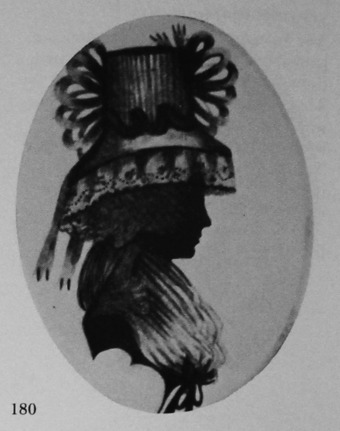
Unknown woman
Silhouette by Mrs Isabella Beetham, 1791-92.
costume dating points
The hair, no longer in the à la conseilleur style but a plain chignon.
The crown of the hat, now higher than before. The ‘lace curtains’ were still popular. The buffon, still in fashion to cover the décolletage.
From the collection of the late J. C. Woodiwiss
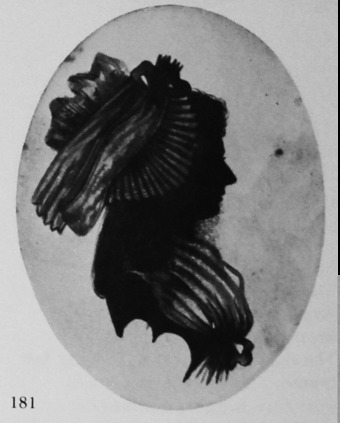
Unknown woman
Silhouette by Mrs Isabella Beetham, c. 1791-92.
costume dating points
The hair, no longer in the à la conseilleur style but a plain chignon.
The extravagant dormouse indoor cap, fashionable in the 1780s and still worn in the early 1790s.
The buffon, still in fashion to cover the décolletage.
D. S. Patton collection
SECTION TWO
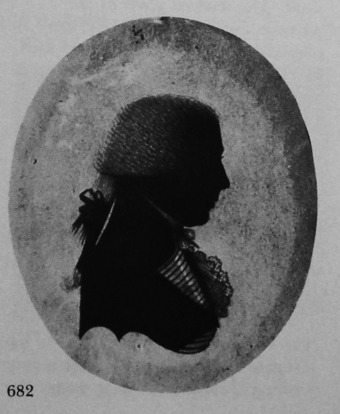
Unknown man
Silhouette painted on thick paper
c. 1785-86
2¾ x 2½in./70 x 64mm.
Frame: oval, hammered brass
Attributed to Mrs Beetham on stylistic grounds. This silhouette shows one type of frock worn at the time: without lapels, and with the waistcoat collar turned back over the frock. The shirt-frills on Mrs Beetham’s silhouettes painted on car are all rendered with some variation.
D. S. Patton collection
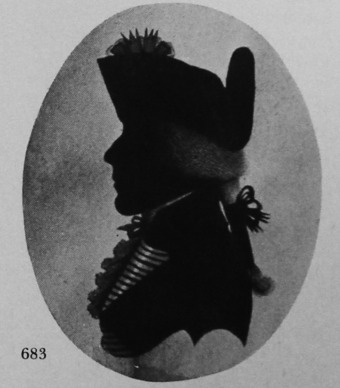
Unknown man
Silhouette painted on thick paper
c. 1785-86
2 ¾ x 2 ½ in./70 x 64 mm.
The sitter is wearing a fantail hat and the striped waistcoat which was fashionable during the 1780s. On Mrs Beetham’s work, the bows of pigtails are often rendered as they are here.
Donals Gildea collection
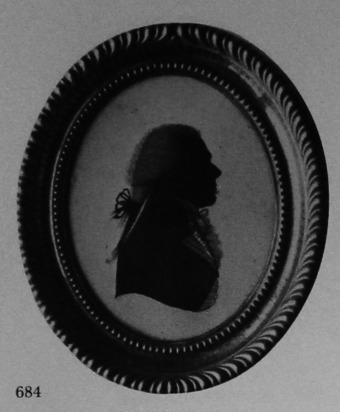
Unknown man
Silhouette painted on thick paper
c. 1785-86
3¼ x 2½in./83 x 64 mm.
Frame: oval, hammered brass
This silhouette is unlabelled, but the style in which the hair is painted, though the double-loop curve at the base is not especially marked, leads one to identify this as Mrs Beetham’s work. The date is suggested by the fact that it was in c. 1785-86 that Mrs Beetham used the type of frame seen here.
D. S. Patton collection
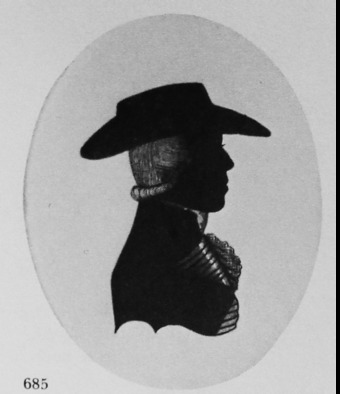
The Reverend J. Drake, D. D., Rector of Amersham
Silhouette painted on thick paper
c. 1787-88
3¼ x 2½in./83 x 64mm.
Trade Label No. 4
Frame: pearwood
This silhouette (probably painted after the subject’s death) shows the striped waistcoat of the period, and the long bob wig which was favoured by clerics.
From the collection of the late J. C. Woodiwiss
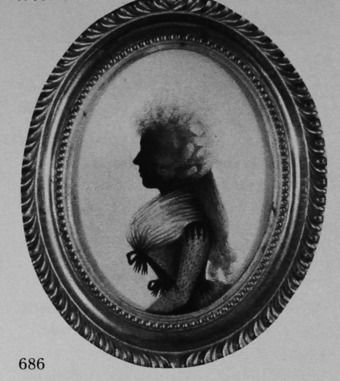
Unknown woman
Silhouette painted on thick paper
c. 1788-89
3 3/8 x 2 5/8 in./86 x 67mm.
Trade Label No. 5
A fine example of Mrs Betham’s work. The darkest parts of the portrait, apart from the face, are painted with gum Arabic mixed with black pigment.
Author’s collection
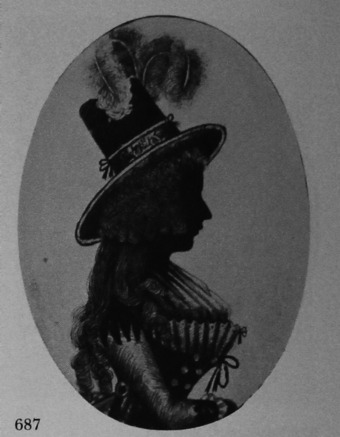
Unknown woman in riding clothes
Silhouette painted on thick paper, with detail in gold
c. 1788-90
3 ½ x 2 ¾ in./90 x 70mm.
Trade Label No. 5 (now removed)
Frame: giltwood
The buttons and the band on the hat are painted in gold. The sitter is wearing a greatcoat riding dress. The dealer from whom the silhouette was acquired for the collection in which it is housed said that he had removed the trade label in order to clean the silhouette.
M. A. H. Christie collection
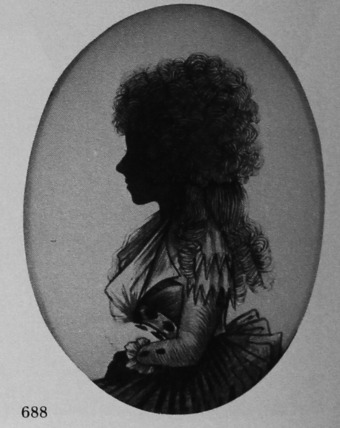
Unknown woman in riding clothes
Silhouette painted on thick paper
c. 1788-90
3 ¼ x 2 ¾ in./83 x 70mm.
Trade Label No. 5
Frame: pearwood
The sitter is wearing a greatcoat riding dress.
J. A. Pollak collection
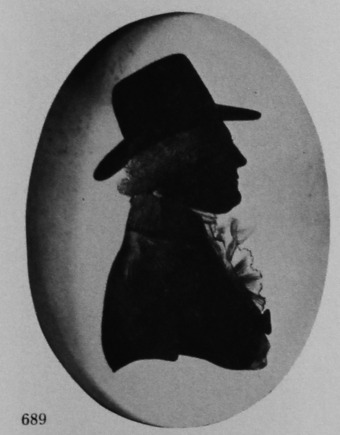
Studio of Mrs Isabella Beetham
William Oakley
Silhouette painted, on thick paper, in black against dark blue
c. 1785-86
3 ½ x 2 ¾ in./90 x 70mm.
Trade Label No. 5
Frame: oval, pearwood
The treatment of this silhouette, painted against dark blue, strongly suggests the hand of Mrs Bull, who was working at the time as Mrs Beetham’s assistant in her studio at 27 Fleet Street, London. A silhouette of a boy, painted in the same style and bearing part of Mrs Beetham’s Trade Label No. 4, is in the same collection.
Note the powder which has fallen on to the sitter’s neck from his wig.
M. A. H. Christie collection
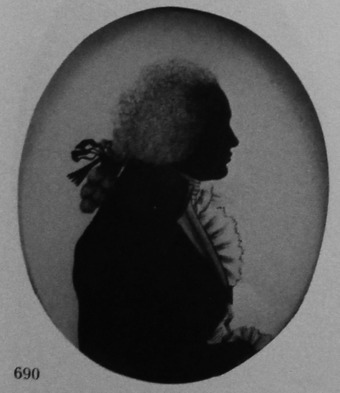
Studio of Mrs Isabella Beetham
Unknown man
Silhouette painted on thick paper
c. 1785-86
3¼ x 2¾in./83 x 70mm.
Trade Label No. 4
The style of painting leads one to attribute this three-quarter length silhouette to Mrs Beetham’s assistant, Mrs Bull.
J. A. Pollak collection
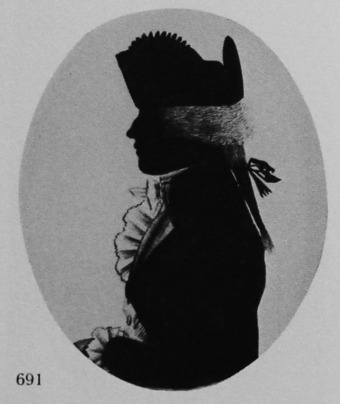
Studio of Mrs Isabella Beetham
Unknown man
Silhouette painted on thick paper
c. 1785-86
3¼ x 2¾in./83 x 70mm.
Trade Label No. 4
Almost of three-quarter length, this silhouette is painted in a style which suggests the hand of Mrs Bull.
J. A. Pollak collection
